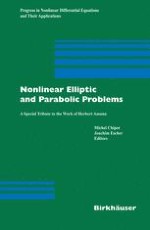2005 | Buch
Nonlinear Elliptic and Parabolic Problems
A Special Tribute to the Work of Herbert Amann
herausgegeben von: Haim Brezis, Michel Chipot, Joachim Escher
Verlag: Birkhäuser Basel
Buchreihe : Progress in Nonlinear Differential Equations and Their Applications
